How to Integrate Video Surveillance Cameras into Your Smart Home System

In the era of smart homes, integrating video surveillance cameras into your system is not just a luxury, it’s a necessity. With the advancement of technology, the ability to monitor your home has become more accessible and user-friendly.
In this article, we’ll guide you through the process of seamlessly adding video surveillance to your smart home, enhancing your security and peace of mind.
Understanding the Basics of Smart Home Video Surveillance
Before diving into the integration, it’s crucial to understand what smart home video surveillance entails. These systems are a combination of digital cameras and internet connectivity, allowing you to view live footage of your home from anywhere in the world. They often come with features like motion detection, night vision, and cloud storage. Choosing the right camera depends on your specific needs, such as the size of your home and the level of monitoring required.
Choosing the Right Cameras
When selecting cameras for your smart home, consider factors like resolution, field of view, and compatibility with existing smart home systems. For comprehensive coverage, you may want to look into options like »live Video Monitoring Toronto,» which offers high-quality surveillance tailored to urban settings. Ensure the cameras you choose can seamlessly integrate with your smart home hub or app for easy management.
Installation and Placement
Proper installation and placement of your cameras are vital for effective surveillance. The cameras should be placed at strategic points around your home, such as entry points, main hallways, and areas where valuables are kept. It’s also important to consider privacy laws and ensure that your cameras are not pointing at public spaces or neighbors' properties.
Connecting to Your Smart Home Network
Once your cameras are installed, the next step is to connect them to your smart home network. This usually involves downloading an app and following the setup instructions to link your cameras to your Wi-Fi network. Most modern surveillance cameras are designed for easy DIY installation and setup, but you can also opt for professional installation if needed.
Integrating with Other Smart Home Devices
The true power of smart home surveillance comes from its integration with other devices. For instance, connecting your cameras to smart locks, lights, and alarms can create a comprehensive security system. You can set up scenarios where the lights turn on automatically if the camera detects motion, or receive alerts on your phone if unusual activity is detected.
Data Storage and Privacy
Data storage and privacy are important considerations. Most smart home surveillance systems offer cloud storage solutions, but you can also opt for local storage. Be mindful of the privacy implications and ensure your system is secure from unauthorized access.
Maintaining and Upgrading Your System
Regular maintenance of your surveillance system is key to ensuring its longevity and effectiveness. Keep the camera lenses clean, check the batteries (if wireless), and update the software regularly. As technology advances, consider upgrading your system to keep up with new features and improvements.
Conclusion
Integrating video surveillance into your smart home system enhances your security and provides peace of mind. By choosing the right cameras, installing them strategically, and connecting them to your smart home network, you can create a robust surveillance system. Remember, the goal is not just to monitor your home but to integrate the surveillance into your daily life, making it a seamless part of your smart home experience.
